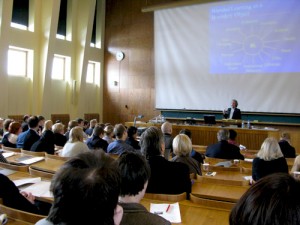*** This is old stuff, but since the next blended learning seminar is coming up and I had this mostly written already, here goes… ***
The 2010 Seminar on Blended Learning was held on the 11-12th of March at the functionally beautiful Metsätalo (“House of Forestry”) in Kaisaniemi, central Helsinki. If you are unsure what blended learning is, here is the Wikipedia link. Simply put, think of it as mixing different modes of teaching in one course…
Keynote speaker Charles Dziuban from the University of Central Florida gave an entertaining presentation on blended learning from his point of view: he has been advocating blended learning & e-learning as solutions to problems with growth inside the university. From the 1970’s the Uni of Central Florida has grown from accommodating 1800 students to a whopping 54.000 students. Of course, in the U.S. more students equals more money more significantly than here, and it is definitely lucrative to offer courses completely on-line in order to save on physical space & travel costs. Students were more satisfied with blended courses than fully online courses, and it was nice to see the claims backed up by some data. American lecturers like Mr. Dziuban are nice to listen to, even if I always get the impression that I’m being sold something rather than being told new things – watching the shopping channel too much on late nights has its drawbacks, I suppose 🙂
Online exams in the blender and in the bed
Taina Joutsenvirta from the Faculty of Social Sciences presented their Moodle-exam pilot, where students can take book exams on Saturdays from any computer they wish by logging into the Moodle course management system, either at home or at the computer class in the city centre. Students and teachers then evaluated their experiences of this way of planning, taking and grading exams, with the following results:
- Good readability of the keyboard-typed answers were generally considered a big plus
- Students liked the fact that they could do the exam in a calm, familiar place (and with no need to dress properly – imagine lying in bed in just your underwear comfortably typing away) which made answering easier.
- There was, however, some discrepancy between students and teachers about the perceived quality of the answers – some teachers thought this type of exam produced poorer answers, and others (esp. students) were more satisfied with the answers they wrote.
- Students liked the applied nature of the questions and felt that they learned more this way – as these weren’t monitored exams the questions had to be designed with a broader scope to cover instead of simply being a test of individual facts, since you can’t know if a student reads his notes, consults a textbook or makes Google searches and such.
- But teachers were worried that too much trust is placed on student ethics – you couldn’t be sure that student’s hadn’t for example used collaborative tactics and shared the exam into several pieces where each student concentrated on one part. The lack of monitoring thus potentially creates unequality compared with students taking the traditional exam, as cheating in one way or another is easier in this type of unmonitored online exam.
Further reading:
The Seminar on Blended Learning (Blog, in Finnish):
https://blogs.helsinki.fi/sulautuvaopetus/
Online exam pilot of the Faculty of Social Sciences (in english):
http://www.helsinki.fi/valtiotieteellinen/opkeh/online_exam.html
Official soundtrack to this post:
Here’s a piece by the Chemical Brothers celebrating the reboot of this blog!
[youtube http://www.youtube.com/watch?v=APqm36XTqKE]
